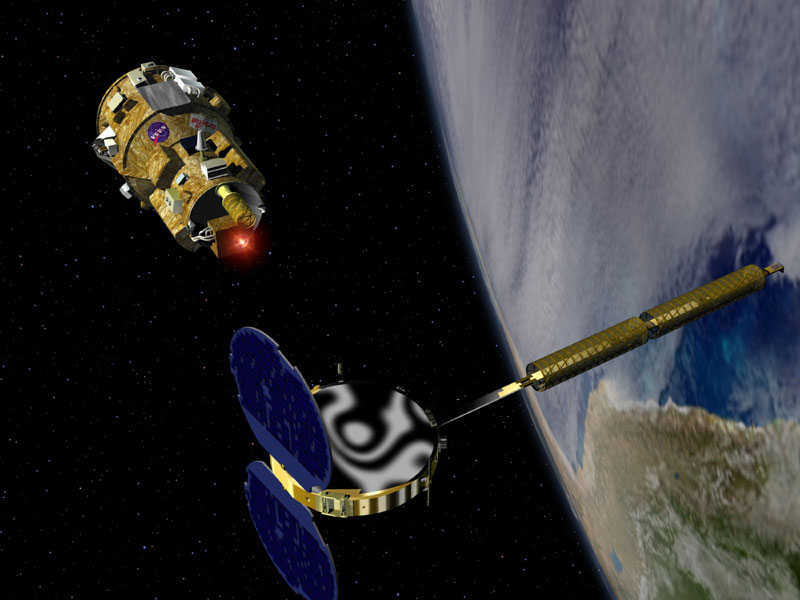NASA Again Poised to Launch Autonomous DART Spacecraft

With lessthan a day remaining before the launch of their autonomous spacecraft, NASAresearchers find themselves in an all-too-familiar position. But hopefully thistime it will be different.
Six months ago,a series of glitches prevented NASA from launch its robotic DART spacecraft ona mission to hunt down and rendezvous with an orbiting satellite. The spaceagency, however, is ready to try again.
"Theexcitement is back up to a fever pitch," said Jim Snoddy,NASA's DART project manager, during a press conference held Thursday at themission's Vandenberg Air Force Base launch site in California. "Space weatheris about the only thing we're looking at for tomorrow's launch."
Researchersattempted to launch DART, short for Demonstration of Autonomous RendezvousTechnology, twice in late October 2004. But several problems, including poorweather,a contaminatedpayload fairing and a communications glitch with DART'starget satellite, forced launch scrubs.
The missionis now set to launch on April 15 between 1:21:49 and 1:28:49 p.m. EDT (1721:49to 1728:49 GMT).
U.S. AirForce Maj. Richard Benz, launch weather officer for the DART space shot, saidweather conditions are favorable for tomorrow's spaceflight, though anotherlaunch window will be available on Sunday if needed.
Robot at the helm
Get the Space.com Newsletter
Breaking space news, the latest updates on rocket launches, skywatching events and more!
DART hasbeen hailed as the first U.S.-built spacecraft designed to fly itself toward an in-orbit rendezvous with another space vehicle, though Russia has used thetechnology for years to control its autonomous Progress cargo shipments to theInternational Space Station (ISS).
TheEuropean Space Agency (ESA) is developing its own unmanned autonomousspacecraft - dubbed the Automated Transfer Vehicle - to loft cargo to the ISS,as is the Japanese Aerospace Exploration Agency (JAXA). Earlier this week, theU.S. Air Force also launched a small satellite, called XSS-11,to demonstrate autonomous rendezvous functions.
Accordingto its flight plan, DART will spent about seven hours flying itself to theMultiple Paths Beyond Line-of-Site Communications (MUBLCOM) satellite, whichhas been in orbit since 1999. About 21 hours into the mission, DART should havecompleted its rendezvous maneuvers and cast itself into a deorbittrajectory that will destroy the autonomous spacecraft. The entire missionshould be over 25 hours after launch.
Instead oflifting off from the ground, DART will get a boost before the engines of itsOrbital Sciences-built Pegasus XL rocket ever ignite. The spacecraft and itsfour-stage rocket will be carried into launch position by the former passengerjet Stargazer L-1011, which will fly to an altitude of about 40,000 feet(12,192 meters) before unleashing its payload above the Pacific Ocean.
"We're looking forward to an uneventfullaunch," said Bryan Baldwin, Pegasus launch vehicle program director forOrbital Sciences, during the press briefing.
Ifsuccessful, DART's launch will be the second spaceshot in two days for NASA.
The nextcrew of the International Space Station (ISS), Expedition11 commander Sergei Krikalevand flight engineer John Phillips, is set to launch spaceward tonightaboard a Soyuz rocket. The flight will also carry visiting astronaut Roberto Vittori,who represents the European Space Agency. That launch is currently scheduled forabout 8:46 p.m. EDT (0046 April 15 GMT) this evening.
Join our Space Forums to keep talking space on the latest missions, night sky and more! And if you have a news tip, correction or comment, let us know at: community@space.com.

Tariq is the Editor-in-Chief of Space.com and joined the team in 2001, first as an intern and staff writer, and later as an editor. He covers human spaceflight, exploration and space science, as well as skywatching and entertainment. He became Space.com's Managing Editor in 2009 and Editor-in-Chief in 2019. Before joining Space.com, Tariq was a staff reporter for The Los Angeles Times covering education and city beats in La Habra, Fullerton and Huntington Beach. In October 2022, Tariq received the Harry Kolcum Award for excellence in space reporting from the National Space Club Florida Committee. He is also an Eagle Scout (yes, he has the Space Exploration merit badge) and went to Space Camp four times as a kid and a fifth time as an adult. He has journalism degrees from the University of Southern California and New York University. You can find Tariq at Space.com and as the co-host to the This Week In Space podcast with space historian Rod Pyle on the TWiT network. To see his latest project, you can follow Tariq on Twitter @tariqjmalik.









